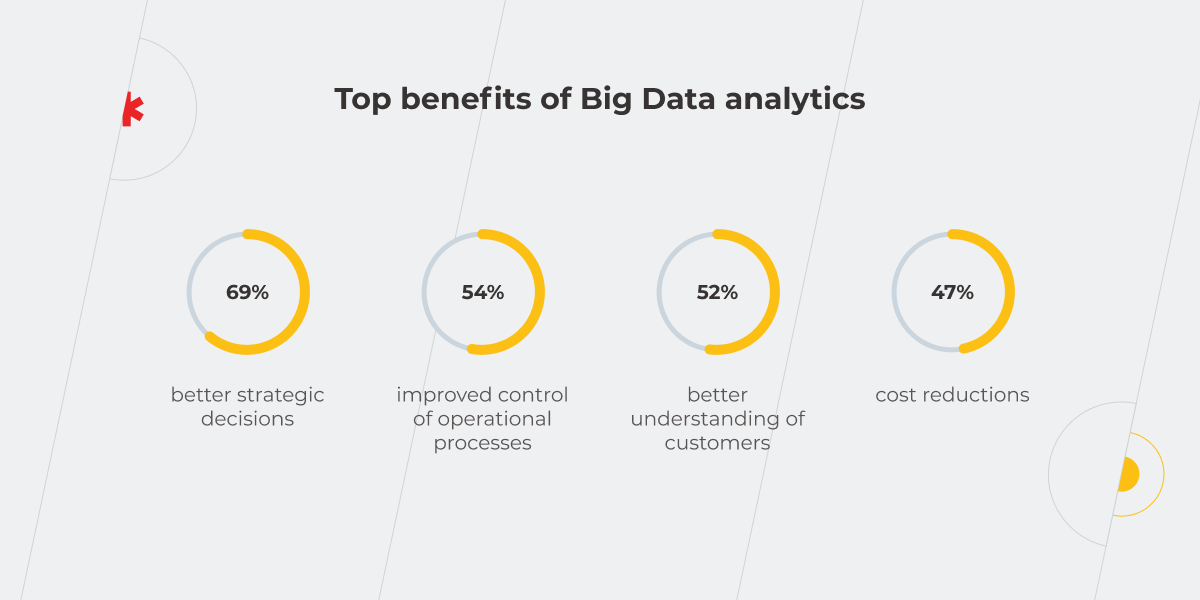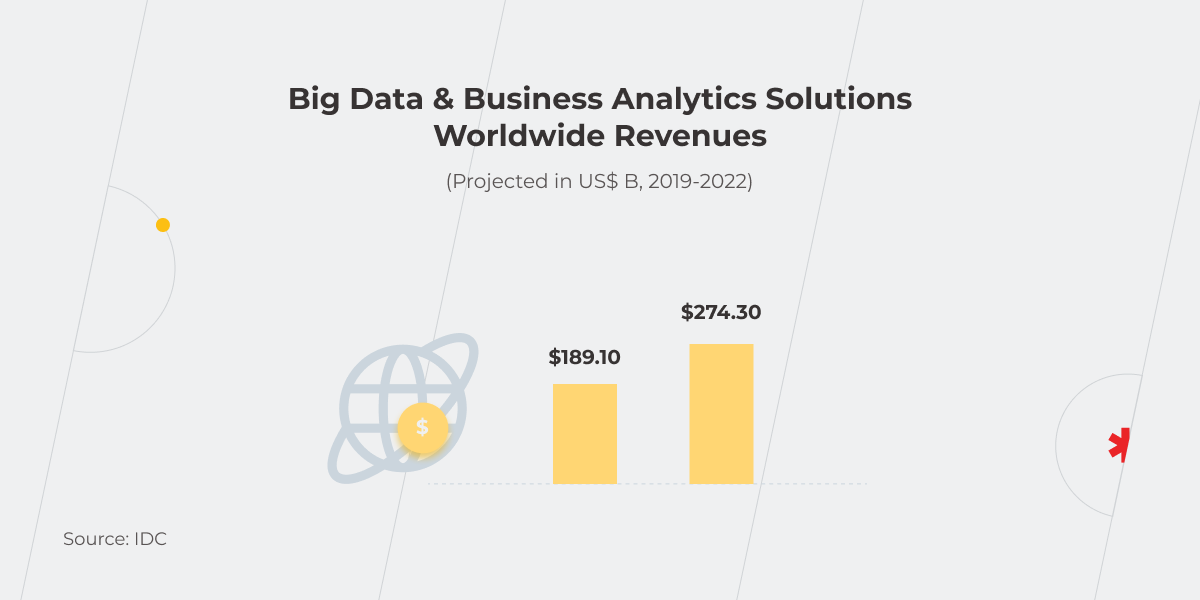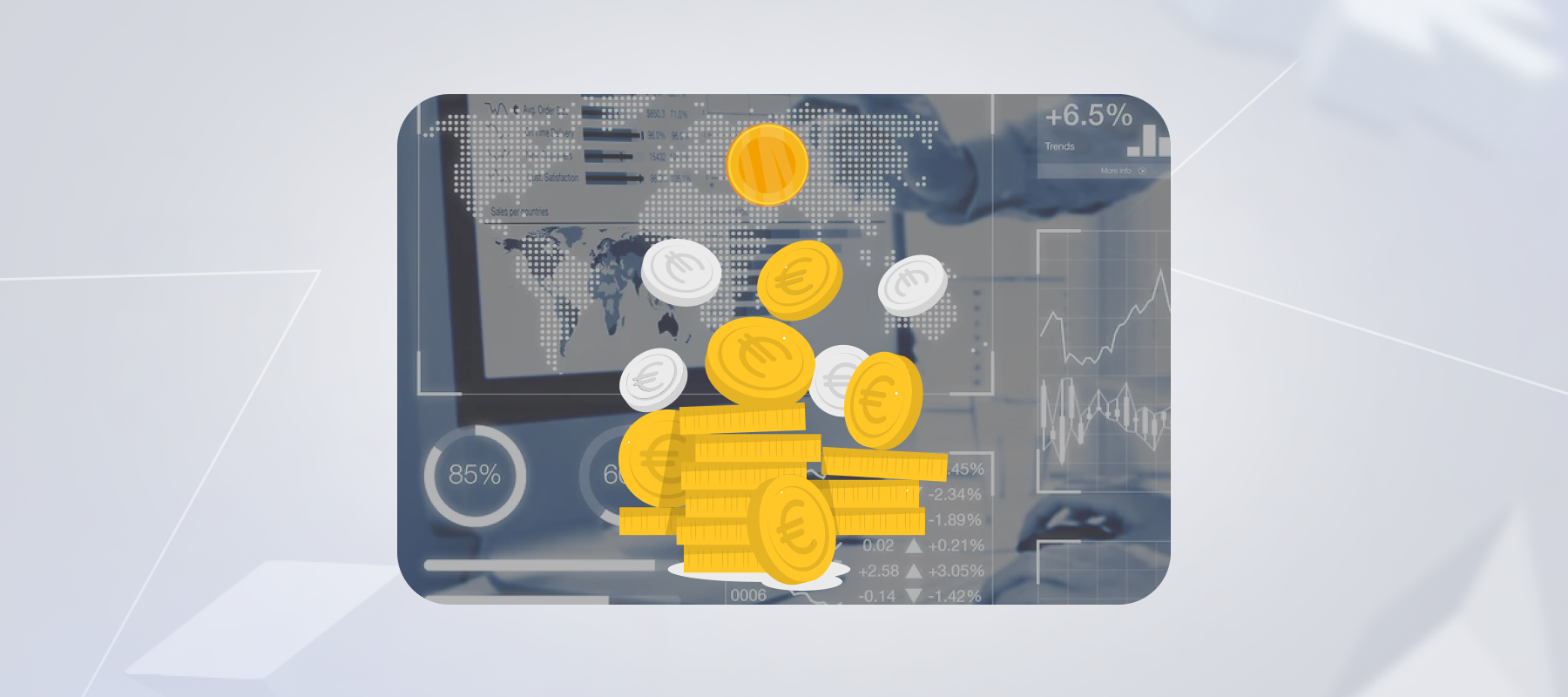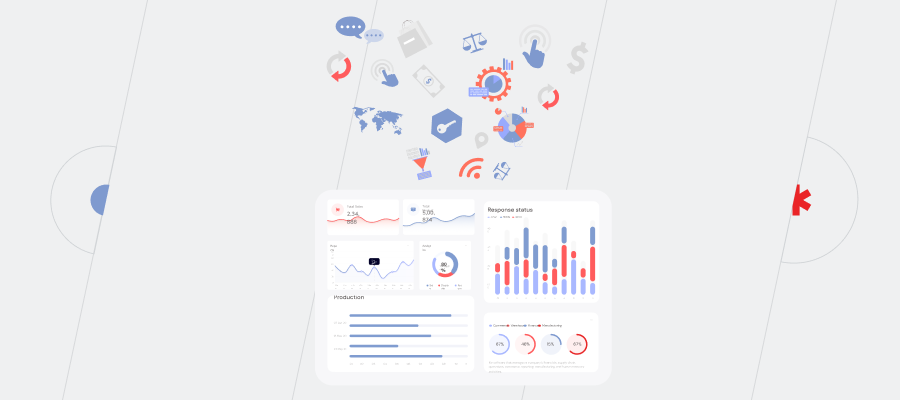Big Data is gaining traction among various industries. According to IBM, people produce 2,500 trillion bytes of data daily. 50 billion IoT and other connected devices gather, analyze, and share it (as CISCO states). Big Data unlocks an excellent opportunity for big insights — available for companies of any domain and size. And this is where an efficient Big Data strategy becomes pivotal.
It’s like aiming at a target and getting a 99% hit because you know where, when, and how to shoot in the most optimal way possible. Big Data makes those “shots” laser-focused, which brings about much more appealing results.
Why is a Big Data strategy important?

Big Data should no longer be regarded as an afterthought. Using the information outside your company’s own data sources, it perfectly fits in your business intelligence solutions and expands the comprehension of the market and customers. The companies that will stay afloat — and ultimately lead the pack — will be the ones that put Big Data amongst such priorities as revenue, profitability, and customer experience.
According to the Broadcast Audience Research Council, Big Data solutions contributed to better decision-making (69%), improved customer experience (52%), and significant cost decrease (47%). What’s more, companies bragged about an 8% increase in revenue and a 10% cost reduction because they treated their Big Data properly.
Therefore, adopting a proper Big Data business strategy makes all the difference in the directions that define business success. But how is this exactly? Let’s find out.
Data-driven decisions
At present, most companies analyze 12% of the information they gather from different sources, while 88% of it stays untapped. Had it been analyzed, it would remove the guesswork and improve the decision-making significantly.
Let’s take an example from marketing. 99% of organizations consider data an integral part of marketing success. Marketers can work out plans strategically based on constant insights from a broad range of meaningful data sources.
As for sales, an effective Big Data business strategy allows sales leaders to operate with more factual sales forecasting data. There’s an immense value in revamping time use among the sales team, enabling them to concentrate on clients most likely to purchase.
Improved internal operations
It takes tons of hours or even days for employees to find the necessary data and process it. When asked to retrieve data to make a decision, only 3% of employees can do it quickly. Big Data, herewith, streamlines operations, exposes inefficiencies, enhances quality control, and drives improvements in every line of business.
Customer service, warehouse management, inventory management, sales — any department can benefit from improved operational processes ensured by a viable Big Data strategy.
Customer-centric approach
Customer-level data sets allow mapping and tracking customer behaviors, needs, and wants across interactions, operations, and transactions. They embrace the whole customer base and span the customer journey, which allows companies to grasp a perfect understanding of customer experiences (CX). That’s why, after scrutinizing its 100 million subscribers, Netflix managed to influence 80% of content consumed by viewers thanks to proper data insights.
When combined with analytics, Big Data sheds light on outcomes such as loyalty, revenue, the cost to serve and helps predict individual customer satisfaction and business efficiency. What’s more, CX management can evaluate the ROI for specific CX investments and align CX initiatives with business outcomes.
The flip side though is that the more available personal data becomes, the more anxiety-provoking the situation is for users. In an age when personal information is the currency that people give for online content and services, innocent competition for customers’ attention has turned into obsessive spying on them. And this is definitely not where Big Data should be headed.
Apple was one of the tech giants who decided to change the direction and give users the choice of whether to be tracked or not, by introducing a pop-up window for iPhones that asks people for their permission to share their information with third parties.
Meanwhile, Facebook messed up (again). The company’s WhatsApp was fined nearly $270 million for not being transparent about how it uses data collected from people using the service.
Not to grapple with fallouts of putting users’ personal information at risk, businesses need to be privacy-conscious while implementing Big Data. Partnering with technology companies, which ensure their solutions comply with privacy policies seems like the best bet.
Reduced costs
Business intelligence strategy and Big Data analytics can change the costs landscape drastically. Executives face storage costs, processing costs, people costs, software costs, etc. Big data deals with these torrents of data in near real-time, pinpoints waste and helps define accurate costs.
A great example is ad campaigns. It’s always essential to have proper market strategies that appeal to end customers. Big data makes this understanding possible. Otherwise, companies have the risk of wastefully spending their precious ad dollars.
Five key steps to deploying a Big Data strategy

Big Data adoption might seem challenging primarily due to the lack of relevant expertise within the organization. Executives feel anxious over finding, hiring, and training Big Data professionals. Besides, there’s a particular difficulty in aligning a new business trajectory with the existing goals of the organization. Here are five steps that might help with the Big Data implementation project plan.
Define your business goals or business problems you’d like to solve
Before embarking on Big Data adoption across the organization, the C-suite should ask where exactly Big Data is needed in the first place. How does it help with that specific problem? Or, does it contribute to the overall business goals?
As Big Data is designed to deliver value by leveraging data, the Big Data strategy needs to tackle key business problems and contribute to the corporate business goals. Here are the initiatives where Big Data can be applied:
- Understanding customer persona
- Prediction of sales
- Analysis of data from different sources
- Identification of financial risks
- Pinpointing of fraud activities or logs
- Tracking of feedback on socials, customer loyalty, Ecomm marketing metrics
- Identification of correlations between many independent data sources
Get a highly skilled team
The right distribution of roles and skill acquisition is integral to Big Data strategy. This is where the HR department is a king. First, it would be wise to assess employee resources. You shouldn’t underestimate your current employees — reskilling and upskilling usually make sense. However, if you feel like you don’t have enough talent to build an in-house Big Data dream team, there’s always the option to attract BI consultants from outside that will help you leverage your data to the fullest.
Execute a current state assessment
An estimation of your company’s current state might address the organization’s assets, sources, processes, capabilities, policies, etc. It is essential to develop an accurate data strategy roadmap that supports what the company aims to be in the future and describes what it is now. Usually, this process requires consultations or interviews with key employees, especially those from clientele targeting and retention, IT functions, and marketing.
For instance, it would be reasonable to gain a good understanding of existing and potential customers when it comes to customer outreach. This becomes doable by evaluating business processes, data architecture and assets, data gathering capabilities, and different policies that affect customer attention and retention.
In the case of data safety, you should start the process of a thorough investigation of current data processes, infrastructure, and policies to build an effective strategy.
Identify what data you need to answer your questions
Deciding on what data is necessary depends on the blind spots businesses need to uncover. What are they? This could be the lack of a full understanding of a customer profile to appeal to when launching custom campaigns. Or, sales leaders might need answers here and now about current critical aspects of business processes.
The operations side of the company, for example, must answer tons of questions that come down to inventory, production, and the supply chain. This data is being captured in an environment enterprises support and manage. The finance department is going through the same processes. Thus, all departments have different use cases, different information, different questions based on revenue costs and clientele.
Choose the right technology for every stage of your data strategy roadmap
According to Forbes, 95% of organizations need to do something about unstructured data. This is where Big Data software, CRMs, and different productivity tools come in handy. Here’s what the roadmap includes:
- Collecting data. The companies gather data from tons of sources like business transactions, industrial gear, socials, IoT devices, and so on. Thus, finding the right technology for this very step is crucial.
- Storing data. Big Data projects require powerful resources for storage. This is where Big Data technologies meet cloud computing for a better, cost-efficient way to deal with all kinds of data.
- Processing data. The tools that allow this could be a real-time distributed tool for capturing data streams, open-source NoSQL database, etc.
- Communicating insights from data. Nowadays, the term ‘democratization of data’ has appeared in the arena. This means not only should data be captured, ‘digested,’ and stored, it needs to be available to all involved in the most optimal manner possible.
Start generating business value with Big Data

The use of Big Data for the competitive advantage of the company is not optional today. It proved its efficiency across departments and processes long ago. That’s why a good Big Data strategy is simply a must to make well-informed business decisions, improve internal operations and customer experiences, and drastically reduce costs in every business line.
Yet, many companies grapple with the lack of expertise in the domain and need proper assistance from the zero phases to freewheeling. 73.4% of organizations confess to having struggles with the integration of Big Data and AI initiatives. So turning to experts, who are good at creating value with big data analytics, might become a game-changer. Our BI team will develop a Big Data strategy that aligns with business goals, capacities, and resources and will be there at every adoption phase.
FAQ:
First and foremost, Big Data is useless without a Big Data strategy. The latter defines the ways data will be exploited in practice and what kind of data management might need to reach particular corporate objectives.
Since more and more data is created and gathered, Big Data is becoming increasingly complex. The only way to benefit from it for particular business goals is to develop a Big Data strategy intentionally.
The implementation might comprise the following stages:
1. Deciding on the data analytics strategy
2. Aggregating the right data
3. Selecting the right productive tools
4. Mapping out an analytical process
5. Teaming up with useful services like cloud computing for better storage, etc.
6. Running a pilot initiative
7. Embedding analytics into decision-making
8. Making essential data available to the whole team
Note, the best practices for Big Data analytics might vary according to a business’s particular nature and this is normal.
To make a business shine amongst competitors, you can use Big Data in the following ways:
– To fix inefficiencies and spot opportunities for growth
– To contribute to innovation and improved design
– To revamp customer experience
– To tackle risks and fraudulent activities










